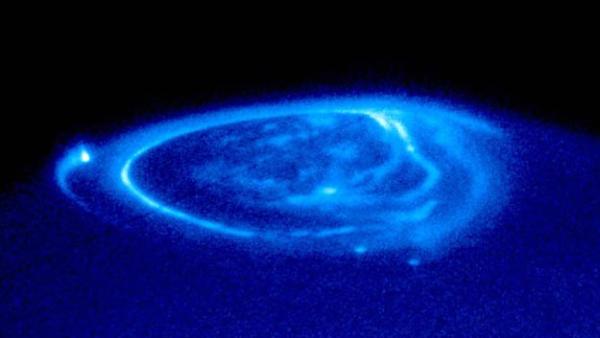
|
Explanation: Jupiter has aurorae. Like Earth, the magnetic field of the gas giant funnels charged particles released from the Sun onto the poles. As these particles strike the atmosphere, electrons are temporarily knocked away from existing gas molecules. Electric force attracts these electrons back. As the electrons recombine to remake neutral molecules, auroral light is emitted. In the above recently released photograph by the Hubble Space Telescope taken in ultraviolet light, the aurorae appear as annular sheets around the pole. Unlike Earth's aurorae, Jupiter's aurorae include several bright streaks and dots. These marks are caused by magnetic flux tubes connecting Jupiter to its largest moons. Specifically, Io caused the bright streak on the far left, Ganymede caused the bright dot below center, and Europa caused the dot to its right.
|
January February March April May June July August September October November December |
| ||||||||||||||||||||||||||||||||||||||||||||||||
NASA Web Site Statements, Warnings, and Disclaimers
NASA Official: Jay Norris. Specific rights apply.
A service of: LHEA at NASA / GSFC
& Michigan Tech. U.
Based on Astronomy Picture
Of the Day
Publications with keywords: aurora - Jupiter
Publications with words: aurora - Jupiter
See also:
- APOD: 2025 April 2 Á Jupiter and Ring in Infrared from Webb
- APOD: 2025 March 9 Á Cyclones at Jupiters North Pole
- APOD: 2025 February 16 Á Perijove 11: Passing Jupiter
- APOD: 2025 January 7 Á A New Years Aurora and SAR Arc
- APOD: 2024 December 8 Á Aurora around Saturns North Pole
- Stereo Jupiter near Opposition
- APOD: 2024 November 3 Á Jupiter Abyss
